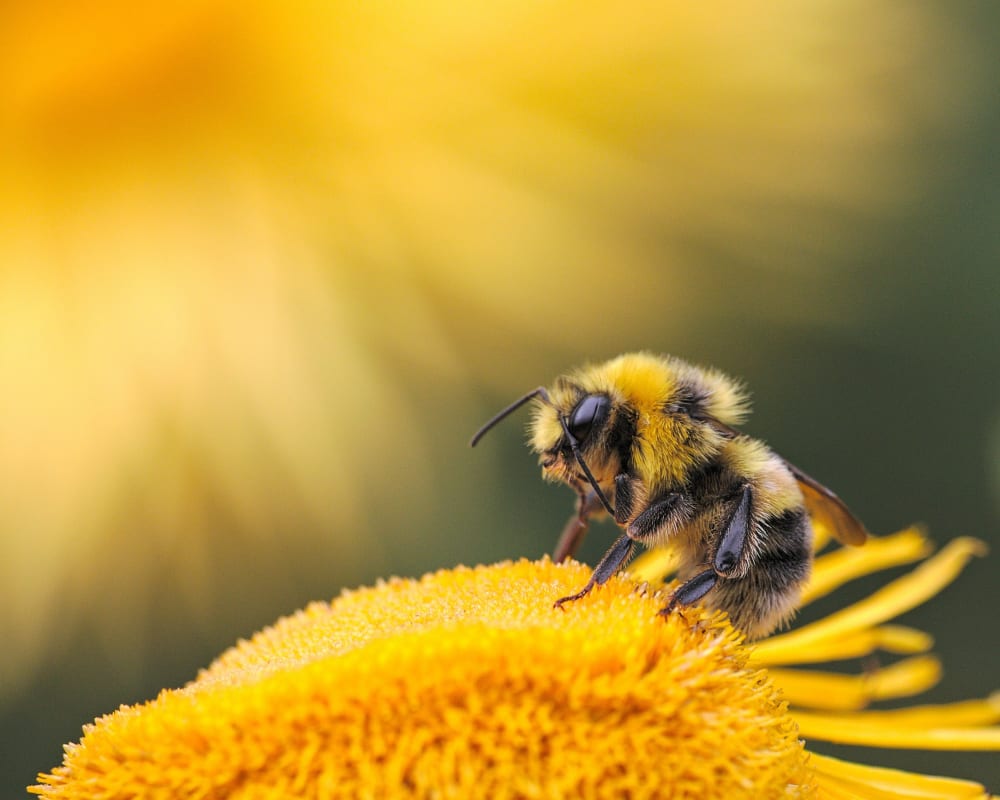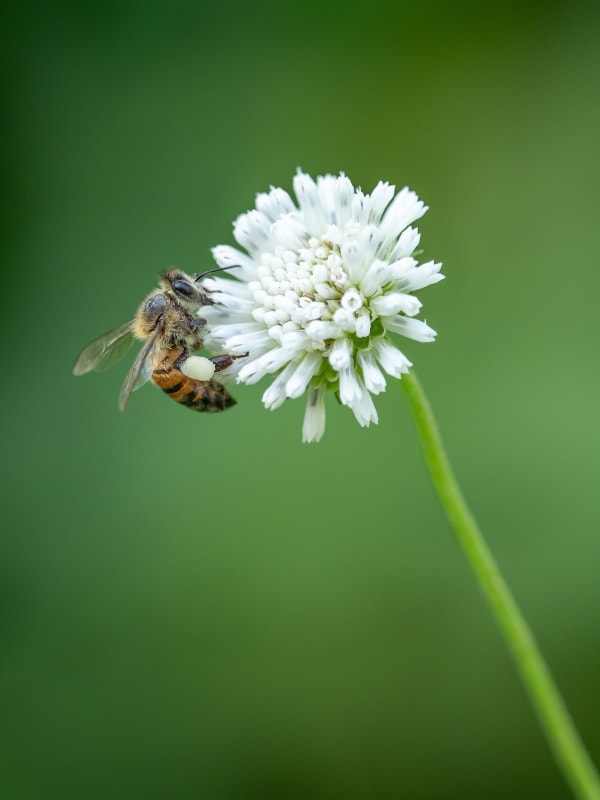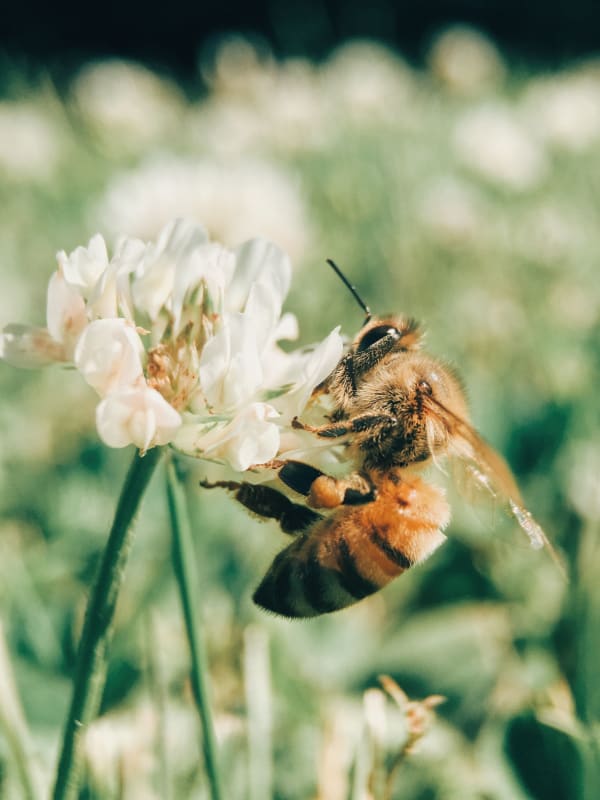Get Buzzed: 3 Amazing Bee Medicines Explained

Get Buzzed: 3 Amazing Bee Medicines Explained
Did you know that honey has antibacterial properties, soothes coughs, and promotes wound healing?
Beauty is in the Hive of the Bee Holder
As a healing and delicious superfood, raw natural honey is a remarkable gem that humans across cultures and millennia have rightfully revered. But make no mistake; honey is not the only delightful golden treasure bees produce. Propolis, pollen, and royal jelly are each quickly making names for themselves as standalone healing remedies and functional foods.
It’s incredible that all four fascinating medicines - honey, propolis, pollen and royal jelly - come from the same fuzzy little pollinators. In assessing the power of each, we can only walk away with a heightened respect for those busy bees.
Propolis
What is it? Bees collect this aromatic wax from various plants encountered on their daily journey. From the Greek pro and polis, meaning defense and city, respectively, propolis almost functions like drywall putty for the hive. Its thick, gummy resin is perfect for patching cracks and renovation projects. This ‘bee glue,’ as it is affectionately known, offers protection against the weather and even predators. The result of liberally using this antifungal and antibacterial hive sealant to bolster the structural integrity of the hive is a safe, hygienic internal space with a consistent internal temperature of 35 degrees Celsius.

What’s in it? In terms of its chemical composition, propolis is mostly resinous wax. However, the remainder is comprised of a deluxe phytochemical explosion featuring more than 300 natural compounds, including terpenes, phenols, 12 different well-studied flavonoids like quercetin, rutin, kaempferol, the life-extending resveratrol (usually associated with red grape skin), a wide range of vitamins and minerals, and bioactive enzymes.
What are the health benefits? Some people find that propolis is beneficial for reducing seasonal allergy symptoms and appears to have antihistaminic and anti-inflammatory qualities.
Studies on melanoma, breast, and lung cancer cells have shown that propolis is toxic to tumours but not normal human cells. Some of these exciting results have prompted interest in developing more research into propolis’ potential to inhibit the proliferation of cancer cells.
Overwhelmingly, propolis is used for applications related to the skin and the gut.
Propolis can be found in capsules, topical creams or balms, soothing throat sprays, or added to honey. Not only do its antiseptic qualities make it a wonderful balm for speeding up external wound healing, but the same properties make it an ally in treating ulceration, increasing the amount of collagen in tissues while soothing and tonifying the mucosal barrier of the gut.
Since these fantastic therapeutic effects involve the whole entourage of phytochemicals propolis has to offer, nothing about it as a food or medicine is simple. Nevertheless, if you want to think of this bee glue as doing the same thing for your own body as it does for the beehive, you won’t be too far off!
Bee Pollen
What is it? Pollen is a crafted mixture of various plant pollen collected by worker bees, combined with their own enzymatic secretions and packed into honeycomb cells. This collaborative project, therefore, varies from region to region based on available flowers.
Ancient Greek, Chinese and Egyptian societies all revered the manifold medicines of the bee. So it should come as no surprise that bee pollen has even been singled out in the medical lore of antiquity. The Ancient Egyptians referred to bee pollen as nothing less than life-giving dust.

What’s in it? Everything bees produce is chemically complex, and pollen is no different: this cocktail contains roughly 250 biologically active chemical compounds. Many of these are well-studied antioxidant phenols like quercetin and chlorogenic acid.
A real source of nutrients, pollen contains all the essential amino acids, fat-soluble vitamins like A, D, and E, almost all the Bs, and even our good friend vitamin C. Various minerals like calcium, potassium, magnesium, copper, iron, and zinc round out the profile and contribute to pollen’s therapeutic effects.
One challenge to the bioavailability of pollen’s nutrients and phytochemicals is a tough outer layer called exine. This unique hard shell seems most efficiently broken down by fermentation and protein-splitting enzymes.
What are the Health Benefits? Compounds in bee pollen have a broad biological impact and a long list of health benefits.
Research has shown them to prevent aging, fight free radical damage, quell inflammation, inhibit cancer spread, and protect cardiovascular function.
Pollen consumption may be most famously known as a natural antihistamine, whether added to honey or swallowed in a capsule. This is owed to its ability to reduce mast cell activation, which translates into a powerful weapon against environmental allergies and respiratory distress. Pollen also accelerates wound healing (much like propolis), so it also appears regularly in topical ointments and balms.
While human trials are lacking, bee pollen has demonstrated impressive benefits in animal research and livestock applications. One rat study revealed a stunning 75 per cent reduction in paw swelling simply from introducing bee pollen to the diet. The therapeutic effects of bee pollen for humans are promising and worthy of proper investigation!
Royal Jelly
What is it? Possibly the single most bizarre thing eaten by humans, there is no question that royal jelly is a superfood - a superfood for bees. A one-of-a-kind compound in the jelly called royalactin alters the expression of a bee’s genes to stimulate the metamorphosis that creates the queen bee.
Royal jelly is secreted by the specialized glands of nurse bees. Except for the little hatchlings, who get it for up to three days, the queen is the only one with access to the off-white creamy acidic delicacy she will enjoy for her entire life.
The superpowers conferred by imbibing this gelatinous cocktail of vitamins, minerals, hormone-stimulating fatty acids, volatile aromatic compounds, and a whole class of “major royal jelly proteins” (MRJP) allow the queen to lay thousands of eggs a day and live up to five years instead of the worker bee’s typical 45 days.

What’s in it? Royal jelly contains bioactive antioxidants, including over 185 detected organic compounds. Many of the chemicals abundant in royal jelly are entirely distinct. Proteins like royalactin are unheard of elsewhere, but so are powerful fatty acids with names like “trans-10-hydroxy-2-decenoic acid” (mercifully referred to as 10-HDA). Along with the amino acids, fats, and carbohydrates, the micronutrient profile of royal jelly makes it a well-rounded nutrition source for bees and humans. It even contains testosterone, estrogen, and progesterone.
What are the health benefits? Royal jelly has been used medicinally for millennia, with Ancient Egyptian and Asian clinicians being notable advocates for its prescription. It has the character of an overall tonic that balances nervous, endocrine and immune systems while simultaneously warding off infection and disease.
- The fatty acids in royal jelly stimulate the birth of new brain cells. Consumption seems to reduce symptoms of depression and anxiety while boosting cognitive function and memory.
- Royal jelly is a potent cardiac elixir that can lower blood pressure while preventing oxidative stress to tissues including the endothelium that lines our heart and blood vessels.
- Numerous research studies have focused on royal jelly’s ability to support hormone balance and increase the production of both testosterone and estrogen.
- Royal jelly inhibits the body’s NF-kB inflammatory pathway, reducing systemic inflammation and rebalancing the body’s immune response away from chronic activation.
- Various compounds in royal jelly have demonstrated pronounced antimicrobial qualities and antagonize a wide range of fungi, yeast, viruses, and bacterial pathogens.
Bee Grateful
It’s genuinely humbling to think of how much bees give us and how hard they work to deliver everything. We know that these cooperative, hardworking insects are critical for the sustainability of our ecosystem. And as if that wasn’t enough, they produce a rainbow of delicious and healing functional foods.
Honey, propolis, pollen, and royal jelly have all earned a place, alone or in combination, in a healthy lifestyle.
These four medicines belong to a category called apitherapy that stands wholly apart from herbal medicine or conventional nutrition. Each one is brimming with fascinating beneficial potential for increasing human vitality that blends the phytochemistry of flowers with the bee’s physiology and ingenuity, resulting in a chemically sophisticated melange of necessary core nutrients and wonderfully unique extras.
It might be easy to overlook the world of bee medicine, but incorporating some of what it has to offer may surprise you with just how real the effects are.
Perhaps it’s time to see what all the buzz is about!
Abdelnour, S. A., Abd El-Hack, M. E., Alagawany, M., Farag, M. R., & Elnesr, S. S. (2018). Beneficial impacts of bee pollen in animal production, reproduction and health. Journal of Animal Physiology and Animal Nutrition, 103(2), 477–484. https://doi.org/10.1111/jpn.13049
Bălan, A., Moga, M. A., Dima, L., Toma, S., Elena Neculau, A., & Anastasiu, C. V. (2020). Royal Jelly-A Traditional and Natural Remedy for Postmenopausal Symptoms and Aging-Related Pathologies. Molecules (Basel, Switzerland), 25(14), 3291. https://doi.org/10.3390/molecules25143291
Braakhuis, A. (2019). Evidence on the health benefits of Supplemental Propolis. Nutrients, 11(11), 2705. https://doi.org/10.3390/nu11112705
Collazo, N., Carpena, M., Nuñez-Estevez, B., Otero, P., Simal-Gandara, J., & Prieto, M. A. (2021). Health promoting properties of Bee Royal Jelly: Food of the Queens. Nutrients, 13(2), 543. https://doi.org/10.3390/nu13020543
Farooqui, T., & Farooqui, A. A. (n.d.). Beneficial effects of propolis on human health and neurological diseases. Frontiers in bioscience (Elite edition). Retrieved March 29, 2023, from https://pubmed.ncbi.nlm.nih.gov/22201913/
Guo, J., Wang, Z., Chen, Y., Cao, J., Tian, W., Ma, B., & Dong, Y. (n.d.). Active Components and biological functions of royal jelly ... Science Direct. Retrieved March 29, 2023, from https://sci-hub.se/10.1016/j.jff.2021.104514
Hattori, N., Nomoto, H., Fukumitsu, H., Mishima, S., & Furukawa, S. (2007). Royal jelly and its unique fatty acid, 10-hydroxy-trans-2-decenoic acid, promote neurogenesis by neural stem/progenitor cells in vitro. Biomedical research (Tokyo, Japan), 28(5), 261–266. https://doi.org/10.2220/biomedres.28.261
Irigoiti, Y., Navarro, A., Yamul, D., Libonatti, C., Tabera, A., & Basualdo, M. (2021). The use of propolis as a functional food ingredient: A Review. Trends in Food Science & Technology, 115, 297–306. https://doi.org/10.1016/j.tifs.2021.06.041
Ito, S., Nitta, Y., Fukumitsu, H., Soumiya, H., Ikeno, K., Nakamura, T., & Furukawa, S. (2012). Antidepressant-like activity of 10-hydroxy-trans-2-decenoic acid, a unique unsaturated fatty acid of royal jelly, in stress-inducible depression-like mouse model. Evidence-Based Complementary and Alternative Medicine, 2012, 1–6. https://doi.org/10.1155/2012/139140
Khalifa, S. A. M., Elashal, M. H., Yosri, N., Du, M., Musharraf, S. G., Nahar, L., Sarker, S. D., Guo, Z., Cao, W., Zou, X., Abd El-Wahed, A. A., Xiao, J., Omar, H. A., Hegazy, M.-E. F., & El-Seedi, H. R. (2021, May 31). Bee Pollen: Current status and therapeutic potential. MDPI. Retrieved March 29, 2023, from https://www.mdpi.com/2072-6643/13/6/1876
Maruyama, H., Sakamoto, T., Araki, Y., & Hara, H. (2010). Anti-inflammatory effect of bee pollen ethanol extract from Cistus sp. of Spanish on carrageenan-induced rat hind paw edema. BMC complementary and alternative medicine, 10, 30. https://doi.org/10.1186/1472-6882-10-30
Pavel, C. I., Mărghitaş, L. A., Bobiş, O., Dezmirean, D. S., Şapcaliu, A., Radoi, I., & Mădaş, M. N. (2011). Biological Activities of Royal Jelly - Review . Scientific Papers: Animal Science and Biotechnologies, 44, 108–118.
Pasupuleti, V. R., Sammugam, L., Ramesh, N., & Gan, S. H. (2017). Honey, Propolis, and Royal Jelly: A Comprehensive Review of Their Biological Actions and Health Benefits. Oxidative medicine and cellular longevity, 2017, 1259510. https://doi.org/10.1155/2017/1259510
Ramadan, M. F., & Al-Ghamdi, A. (2012). Bioactive compounds and health-promoting properties of Royal Jelly: A Review. Journal of Functional Foods, 4(1), 39–52. https://doi.org/10.1016/j.jff.2011.12.007
Raman, R. (2018, August 13). Top 11 Health Benefits of Bee Pollen. Healthline. Retrieved March 29, 2023, from https://www.healthline.com/nutrition/bee-pollen#TOC_TITLE_HDR_2
Rivera-Yañez, N., Rivera-Yañez, R., Pozo-Molina, G., Méndez-Catalá, C. F., Méndez-Cruz, A. R., & Nieto-Yañez, O. (n.d.). Biomedical properties of propolis on diverse chronic diseases and its potential applications and health benefits. Nutrients. Retrieved March 29, 2023, from https://pubmed.ncbi.nlm.nih.gov/33383693/
Rzepecka-Stojko, A., Stojko, J., Kurek-Górecka, A., Górecki, M., Kabała-Dzik, A., Kubina, R., Moździerz, A., & Buszman, E. (2015). Polyphenols from Bee Pollen: Structure, Absorption, Metabolism and Biological Activity. Molecules (Basel, Switzerland), 20(12), 21732–21749. https://doi.org/10.3390/molecules201219800
Taşdoğan, A. M., Pancar, Z., Özdal, M., Vural, M., Pancar, S., & Birinci, Y. Z. (2020). The effect of short-term royal jelly supplement on testosterone levels in sedentary and healthy individuals. Progress in Nutrition, 22(1). https://doi.org/10.23751/pn.v22i1.8746
Zulhendri, F., Felitti, R., Fearnley, J., & Ravalia, M. (2021). The use of propolis in dentistry, Oral Health, and Medicine: A Review. Journal of Oral Biosciences, 63(1), 23–34. https://doi.org/10.1016/j.job.2021.01.001
